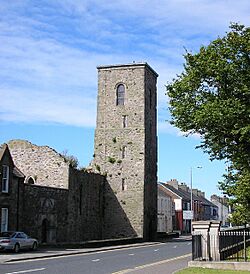Newtownards Priory facts for kids
 |
|
| Monastery information | |
|---|---|
| Order | Dominican Order |
| Established | c. 1244 |
| Disestablished | 1541 |
| People | |
| Founder(s) | the Savage family |
| Site | |
| Location | Newtownards, County Down |
| Public access | Yes |
Newtownards Priory was an old Dominican priory (a type of monastery) built by the Savage family. It was started around the year 1244 in the town of Newtownards, which is in County Down, Northern Ireland.
Contents
What is Newtownards Priory?
A priory is a building where a group of religious people, like monks or nuns, live and pray together. Newtownards Priory was home to Dominican friars. These friars were part of the Dominican Order, a Christian group founded in the 13th century.
How the Priory Looked
When you visit the priory today, you can still see some of its oldest parts. The lower walls of the main church area, called the nave, are from when it was first built. There are also two doorways in the south wall that used to lead to a cloister, which was a covered walkway. This cloister is no longer there.
Later on, in the 14th century, the upper parts of the nave were rebuilt. The de Burgh family also added a western extension and a row of arches (called an arcade) in the north aisle. This shows how the priory changed and grew over many years.
The Priory's End and New Beginnings
In 1541, the priory was officially closed down. This was part of a big change in Ireland called the Irish Reformation, when many monasteries were dissolved. After it was closed, the priory was attacked and burned.
Later, the land and ruins were given to a man named Hugh Montgomery. He decided to build a house right inside the old priory ruins. He also rebuilt the north aisle and added a tower at the entrance. This shows how old buildings can be reused and changed over time.
Important Graves at the Priory
Inside the church part of the priory, you can find a special double grave. This is where Frederick Stewart, 4th Marquess of Londonderry and his wife, Elizabeth née Jocelyn, are buried. Frederick Stewart lived from 1805 to 1872, and Elizabeth lived from 1813 to 1884. They were important figures in the history of the area.

